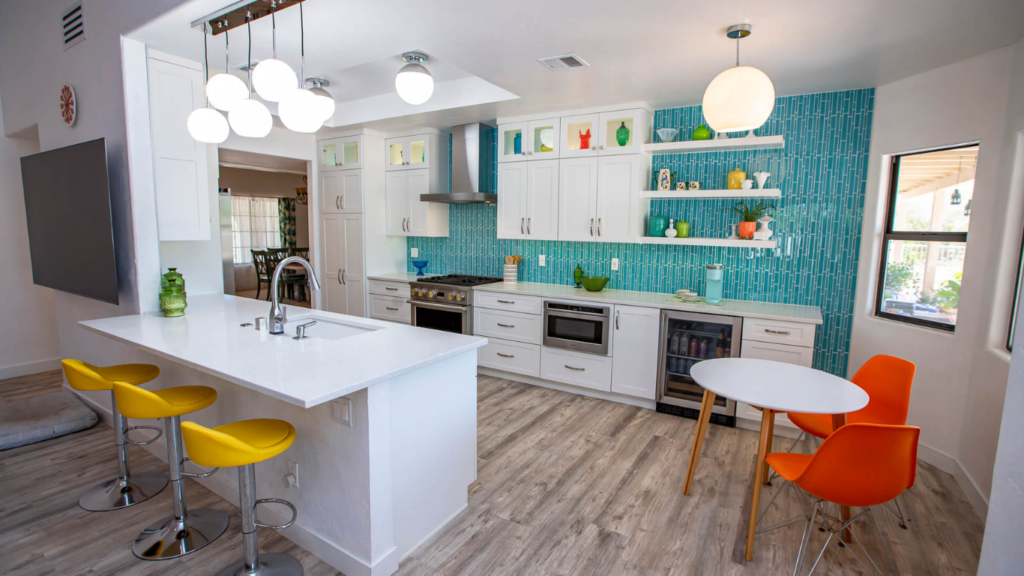Introduction
The kitchen creates two outstanding design functions through the provision of functionality capabilities while conveying personal style and appearance. Hazard in the kitchen setting occurs when individuals make erroneous color selections impacting all their appliances, cabinets, and construction materials. The strategic partnership between appliances and cabinets with materials brings functional and visual appeal that guides users to enjoyable comfort. The subsequent analysis presents color selection principles in this article and effective approaches to developing harmonious kitchens according to your character profile and daily routines.
Emotional color association
How people engage in their environment depends on the psychological functions of different colors. Food preparation spaces require specific color selections to elicit particular user emotions. Every kitchen space gains appetite stimulation and cozy feelings through the color’s red, orange, and yellow, yet blue-green hues maintain a peaceful, serene atmosphere. You should select kitchen colors carefully because they create pleasurable cooking moments and bring enjoyment to your family time in the kitchen space.
Balancing Functionality with Aesthetic Appeal
Design functionality maintains an equal importance with visual appeal because the main goal is an integrated relationship between purpose and appearance. Every component in your selected color scheme for kitchen appliances and cabinets should support the space’s primary function. Areas enclosed by light tones appear larger, while dark hues generate coziness and tastefulness in kitchen spaces. When practical needs balance with design aesthetics you will obtain a kitchen that efficiently handles daily tasks while maintaining attractive aesthetics.
Choosing Colors for Kitchen Appliances
Kitchen appliances are the central design feature, drawing eyes within the room. Color choosing of the kitchen appliances determines the look of the entire room by modifying its visual composition. The stainless-steel finish provides contemporary kitchens with a new appearance, but black and white appliances suit rooms that prefer an eternal look. Design elements, quality of finish, and overall theme for kitchen should be considered when you are making decisions about the appliance colors you use.
Choosing the Right Cabinet Colors
The main character of the room emerges from the color choices in the kitchen cabinets. A person selecting kitchen cabinet colors should weigh the design aspects of appearance alongside practical functionality. The expanded appearance of small kitchens depends mainly on using light cabinetry in soft whites alongside creams and light grays. Rooms acquire sophistication through bold statements from deep blue, dark black, and charcoal brown colors. Neutral beige and taupe options work well across various kitchens since they pair with multiple countertops and backsplash materials.
Creating Contrast with Accent Colors
Accent colors transform your kitchen design into a visually lively space whenever they surface on your backsplash tile sur, dining ware, and embroidered home decor elements. Interior designers must use accent colors that match the main kitchen color scheme consisting of appliances, cabinets, and all materials involved. The three colors, red, yellow, and green, serve effectively as accent hues in kitchen design since they insert visually compelling areas while increasing space energy without disrupting the predominant color flow.
The Role of Lighting in Color Selection
Proper illumination plays a decisive role in kitchen design creation since this crucial element remains understated despite being essential to the outcome. The selected lighting affects how visitors perceive colors throughout the entire area. The space’s appearance becomes more vibrant, and its colors seem more pronounced upon entry of natural outdoor light. The color of artificial light alters based on cold and warm illumination temperatures. Carefully examine how daily and night illumination affects apple color selection, cabinet nets, and material choices.
Considering Trends vs. Timelessness
Several current design patterns drive house owners to choose their kitchen color scheme. Timeless design options preserve their value for years since they naturally resist short-lived trends. Business-oriented color choices must match durable color selections because enduring elements will maintain their attractiveness for future periods. Elegant kitchens depend on white, gray, or navy colors, as these classic choices remain unfashionable. At the same time, modern accents create an up-to-date look while avoiding costly color trends with brief popularity.
Mixing and Matching Different Materials

Modern kitchens implement diverse materials to construct interesting, dynamic kitchen areas. The visual quality of a design rises dramatically when wood combines with metal stone alongside glass materials within a single space. All chosen material colors need to function properly when mixed. Light wood cabinets achieve a stunning aesthetic effect together with polished metal fixtures while they face granite countertops. Several materials combined in kitchens generate unique visual patterns that create exclusive design elements that preserve balanced aesthetics.
Dimensions in various colors enable compact kitchens to function better.
The optimal method to optimize restricted kitchen areas depends on deliberate color plans. Light pastel tones, soft beige, and white colors help a space absorb more luminosity and create a perception of larger dimensions and open areas. Designers apply monochromatic color rules to create visual cohesion because the design incorporates a single color stretching across all walls, cabinets, and appliance surfaces. The deepening effect of small kitchens occurs when designers use glossy elements along with matte surfaces, as these elements maintain visual unity without creating disorder. A specific color choice can increase the apparent size of compact kitchens.
An uncompromised connection between adjacent rooms needs detailed evaluation.
Analyze how your kitchen colors should complement the adjacent living areas, dining rooms, and living rooms before making your definite choice. All spaces, from the kitchen to the open concept, must use consistent colors on an untreated surface to create a unified visual flow in the central area. Any kitchen appliances, cabinets, and materials must exhibit colors that match those of dining and living areas that share space. Thanks to this relationship, these two spaces achieve seamless visual integration.
During the product selection process designers focus on longevity together with design characteristics.
Sustainability and excellent quality performance represent absolute requirements when picking materials for kitchens. These materials need top priority because they face constant heavy use daily. Active kitchen areas benefit maximally from quartz and granite materials with stainless steel elements because these substances demonstrate premium quality and sturdy resistance. Bamboo materials and reclaimed wood demonstrate exemplary support for revolutionary sustainable design principles while delivering eco-friendly characteristics and reliable strength.
Conclusion
The arrangement of meaningful kitchen elements requires specific color choices to achieve a balanced style combination. Following psychological assessments and functional n, functional needs enable homeowners to build attractive, welcoming kitchen spaces. Use colors and textures to establish cohesive balance because achieving this objective is your primary aim. The proper execution of planning steps enables your kitchen to develop your home’s an elegant, functional home.

